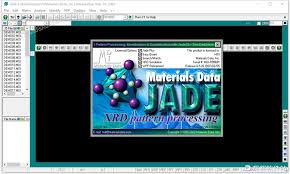
MDI Jade 6.5
XRD; Data confirmation; JCPDF Card no; Crystal Structure
Description:
Modern materials research heavily depends on the precise characterization of crystalline structures, and X-ray diffraction (XRD) is a fundamental technique used to investigate phase composition, crystallite size, and crystal structure. Among the software tools available for XRD data interpretation, MDI Jade, developed by Materials Data Inc. (MDI), stands as one of the most reliable and widely used programs for qualitative and quantitative analysis of powder diffraction patterns.
Jade is known for its high-speed pattern processing, advanced peak analysis tools, and seamless integration with the ICDD PDF (Powder Diffraction File) database. The software supports data from a wide variety of XRD instruments (e.g., PANalytical, Bruker, Rigaku, Shimadzu), and provides an intuitive yet highly flexible environment for researchers in materials science, chemistry, solid-state physics, and geology.
MDI Jade is particularly appreciated for its clean interface and powerful data interpretation capabilities that do not require complex programming skills. The software is structured to accommodate users at all levels—offering quick phase identification for beginners and deep analytical tools like whole pattern fitting, profile matching, and Rietveld refinement for experienced crystallographers.
Key Features and Capabilities
At its core, MDI Jade offers automatic peak detection, background correction, K-alpha2 stripping, smoothing, and zero-shift correction, which are critical preprocessing steps in XRD analysis. Once the pattern is corrected and peaks are identified, users can initiate phase identification using search-match routines connected to the ICDD PDF-2 or PDF-4+ databases. Jade’s algorithms quickly compare experimental peak positions and intensities with reference patterns and suggest the best possible phase matches based on quality scores and d-spacing fits.
Jade also enables quantitative phase analysis using both relative intensity ratios and advanced methods like Reference Intensity Ratio (RIR) and Rietveld refinement (in Jade Pro or Jade Plus versions). These features are useful when dealing with multiphase mixtures, impurities, or doping in advanced materials, allowing researchers to determine exact weight fractions and structural characteristics.
Another important capability of Jade is its support for profile fitting using pseudo-Voigt or Pearson VII functions, which allows for precise determination of peak positions, full width at half maximum (FWHM), and integrated intensities. These values can then be used to calculate crystallite size and microstrain using the Scherrer equation or Williamson–Hall plot—essential for nanomaterials and thin film analysis.
Visualization and Analysis Tools
Jade offers real-time visualization of diffraction data with flexible zooming, overlaying, and annotation features. Users can easily compare patterns of treated vs. untreated samples, identify phase transitions, and observe peak shifts caused by lattice distortion or thermal expansion. The software allows for side-by-side comparison of multiple patterns, making it ideal for time-resolved studies, sintering behavior analysis, or compositional variation.
Graphs and tables generated by Jade can be directly exported to image formats, Excel, or other reporting tools, facilitating publication-quality figures and detailed documentation. The software also includes batch processing and scripting capabilities, which can save time during the evaluation of a large number of samples or high-throughput experiments.
Advanced Features and Research Benefits
In addition to standard pattern matching and peak analysis, MDI Jade offers several advanced modules and options that enhance its functionality:
-
User-defined databases: Researchers can create their own phase libraries with customized entries and private references.
-
Difference plot visualization: Jade shows the residual between the experimental and calculated pattern, allowing users to visually assess the quality of fit.
-
Crystallographic tools: Includes lattice parameter refinement, indexing, space group analysis, and preferred orientation detection.
-
Overlay tools: Helps compare experimental data with reference patterns or multiple phases within the same sample.
These features are particularly beneficial for researchers working on doped materials, hybrid composites, or advanced nanostructures where small structural variations must be precisely analyzed.
Conclusion
MDI Jade is a professional-grade software for comprehensive XRD data analysis, offering a wide range of capabilities from basic peak identification to advanced crystallographic modeling. Its compatibility with major XRD instruments, rapid phase identification routines, and powerful analytical tools make it a preferred choice for researchers in both academia and industry. Whether investigating unknown phases in a mineral sample, analyzing phase purity of synthesized nanoparticles, or studying thermal-induced phase transitions, Jade simplifies the process and enhances the reliability of results.